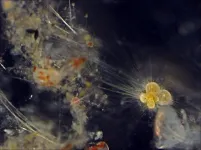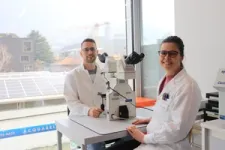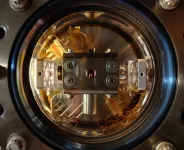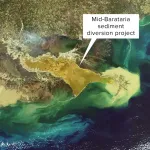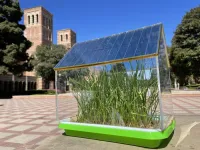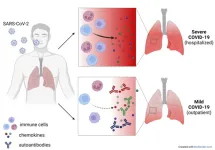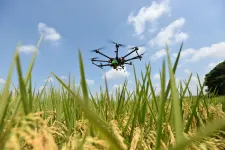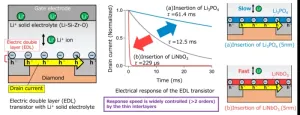(Press-News.org) Mineral particles played a key role in raising oxygen levels in the Earth’s atmosphere billions of years ago, with major implications for the way intelligent life later evolved, according to new research.
Up to now, scientists have argued that oxygen levels rose as the result of photosynthesis by algae and plants in the sea, where oxygen was produced as a by-product and released into the atmosphere.
But a research team at the University of Leeds say the photosynthesis theory does not fully explain the increase in oxygen levels.
In a paper published today (Monday, March 6) in the journal Nature Geoscience, the researchers argue that when the algae and plants died, they would have been consumed by microbes, a process that takes oxygen from the atmosphere.
As a result, the amount of atmospheric oxygen was a balance between what was produced through photosynthesis and what was lost as a result of decomposition of the dead plant and algae.
To enable the atmospheric oxygen levels to get higher, the scientists say the process of decay must have been slowed or halted. This happened through what is known as mineral-organic carbon preservation, where minerals in the oceans, particularly iron particles, bind onto the dead algae and plants and inhibit their decay and decomposition.
The overall result is that oxygen levels were able to increase unhindered.
Caroline Peacock, Professor of Biogeochemistry in the School of Earth and Environment at Leeds who led the research, said: “Scientists have known for many years that mineral particles can bind with dead algae and plants, making them less susceptible to attack by microbes and shielding them from the decay process, but whether mineral particles helped fuel the rise of atmospheric oxygen had never been tested.”
The researchers set about testing their theory against known geological events when levels of mineral particles were likely to have been higher, for example, when the continents formed, resulting in a greater landmass from which minerals - including particles of iron - would have blown or been washed into the oceans.
For example, the Great Oxidation Event 2.4 billion years ago saw a spike in oxygen levels in the atmosphere. This coincided with the gradual formation of the continents, which would have caused a greater quantity of mineral particles to flow into the oceans.
Dr Mingyu Zhao, formerly at Leeds but now at the Chinese Academy of Sciences in Beijing, performed the study. He said: “The increase in mineral particles in the oceans would have reduced the rate at which algae was being decomposed. This had a major impact on oxygen levels, allowing them to rise.”
The increase in atmospheric oxygen had major ramifications for the development of life. It resulted in the evolution of increasingly complex organisms, which moved from inhabiting water to living on land.
For Professor Peacock, the study not only brings greater understanding to the way the Earth’s atmosphere became oxygenated, it also gives a glimpse of the conditions that are necessary for complex life to develop on other planets.
She said: “Our investigation is providing a new understanding of how the Earth’s atmosphere became oxygen rich, which eventually enabled complex life forms to evolve.
“That is giving us an important insight into the conditions that need to exist on other planets for intelligent life to develop.
“The existence of water on a planet is only part of the story. There needs to be dry land to provide a source of mineral particles that will eventually end up in the oceans.”
When the embargo lifts, the paper - titled 'Oxygenation of the Earth aided by mineral-organic carbon preservation' - will be available on the Nature website: https://www.nature.com/articles/s41561-023-01133-2
The paper was authored by Mingyu Zhao, Benjamin J. W. Mills, William B. Homoky and Caroline L. Peacock, all from the University of Leeds.
END
Mineral particles and their role in oxygenating the Earth’s atmosphere
2023-03-06
ELSE PRESS RELEASES FROM THIS DATE:
Two-dimensional quantum freeze
2023-03-06
Glass nanoparticles trapped by lasers in extreme vacuum are considered a promising platform for exploring the limits of the quantum world. Since the advent of quantum theory, the question at which sizes an object starts being described by the laws of quantum physics rather than the rules of classical physics has remained unanswered.
A team formed by Lukas Novotny (Zurich), Markus Aspelmeyer (Vienna), Oriol Romero-Isart (Innsbruck), and Romain Quidant (Zurich) is attempting to answer precisely this question within the ERC-Synergy project Q-Xtreme. A crucial step ...
Scientists twist chemical bonds beyond their limits
2023-03-06
A group of scientists from Durham University and University of York have twisted molecules to their breaking point in order to challenge the understanding of chemical bonds.
The researchers explored how far the chemical bonding in an aromatic ring can be twisted before its aromatic bonding breaks.
They achieved this by making overcrowded aromatic rings. Rather than benzene, they used tropylium, which shares electrons around a ring of seven carbon atoms.
Each of these carbon atoms can be functionalised and having seven attachment points in the ring, rather than the six carbon atoms of benzene, allowed ...
Siblings should be screened in cases of suspected child physical abuse
2023-03-06
Siblings of a child suspected of experiencing physical abuse should also be screened for abusive injuries, according to a new international consensus statement led by researchers at UCL (University College London) and Great Ormond Street Hospital for Children (GOSH).
The team of 27 researchers, from six different continents, are calling for a policy change to stop inconspicuous injuries being missed in contact children (i.e. siblings, cohabiting children, or children who are under the same care), and to help prevent further ...
Rewarding accuracy instead of partisan pandering reduces Republican-Democrat divide over the truth – study
2023-03-06
Offering a tiny cash reward for accuracy, or even briefly appealing to personal integrity, can increase people’s ability to tell the difference between misinformation and the truth, according to a new study.
The findings suggest that fake news thrives on social media not only because people are tricked into believing it, but also due to a motivational imbalance: users have more incentive to get clicks and likes than to spread accurate content.
Social psychologists from the University of Cambridge and New York University argue that their study, published in the journal ...
New study compares human contributions to Mississippi river delta land loss, hints at solutions
2023-03-06
Research from scientists at Louisiana State University and Indiana University reveals new information about the role humans have played in large-scale land loss in the Mississippi River Delta—crucial information in determining solutions to the crisis.
The study published today in Nature Sustainability compares the impacts of different human actions on land loss and explains historical trends. Until now, scientists have been unsure about which human-related factors are the most consequential, and why the most rapid land loss in the Mississippi River Delta occurred between the 1960s and 1990s and ...
UCLA engineers design solar roofs to harvest energy for greenhouses
2023-03-06
As countries around the globe seek sustainable energy sources and the U.S. endeavors to become a net-zero emissions economy by 2050, renewable energy sources such as solar panels are in high demand.
However, solar panels can take up significant space and are often difficult to scale. Enter the new field of agrivoltaics, which focuses on the simultaneous use of land for both solar power generation and agriculture. For example, replacing the glass in greenhouses with solar panels could power the lamps and water controls in the greenhouse, or even the whole farm. But how does one build solar panels that can absorb energy from sunlight without blocking the light ...
'Good autoantibodies' could help against long Covid
2023-03-06
Sometimes in the laboratory there are unexpected results. "Previously it had been observed that autoantibodies are common in severe Covid patients, those who end up in intensive care," says Jonathan Muri, postdoctoral fellow at the Institute for Research in Biomedicine (IRB, affiliated with the Università della Svizzera italiana) and co-author of the study. "Instead, in this case we discovered the opposite."
The autoantibodies in question neutralize chemokines, molecules that direct immune cell trafficking. "Chemokines are a bit like traffic lights: they tell our immune cells when and where to go in the case ...
Drones and deep learning: researchers develop a new technique to quantify rice production
2023-03-06
Rice, a major food crop, is cultivated on nearly 162 million hectares of land worldwide. One of the most commonly used methods to quantify rice production is rice plant counting. This technique is used to estimate yield, diagnose growth, and assess losses in paddy fields. Most rice counting processes across the world are still carried out manually. However, this is extremely tedious, laborious, and time-consuming, indicating the need for faster and more efficient machine-based solutions.
Researchers from China ...
Controlling electric double layer dynamics for next generation all-solid-state batteries
2023-03-06
In our quest for clean energy and carbon neutrality, all-solid-state lithium-ion batteries (ASS-LIBs) offer considerable promise. ASS-LIBs are expected to be used in a wide range of applications including electric vehicles (EVs). However, commercial application of these batteries is currently facing a bottleneck—their output is reduced owing to their high surface resistance. Moreover, the exact mechanism of this surface resistance is hitherto unknown. Researchers have alluded it to a phenomenon called the “electric ...
Study finds silicon, gold and copper among new weapons against COVID-19
2023-03-06
New Curtin research has found the spike proteins of SARS-CoV-2, a strain of coronaviruses that caused the COVID-19 pandemic, become trapped when they come into contact with silicon, gold and copper, and that electric fields can be used to destroy the spike proteins, likely killing the virus.
Lead researcher Dr Nadim Darwish, from the School of Molecular and Life Sciences at Curtin University said the study found the spike proteins of coronaviruses attached and became stuck to certain types of surfaces.
“Coronaviruses have spike proteins on their periphery that allow them to penetrate host cells and cause infection and we have found these proteins becomes stuck to the surface ...
